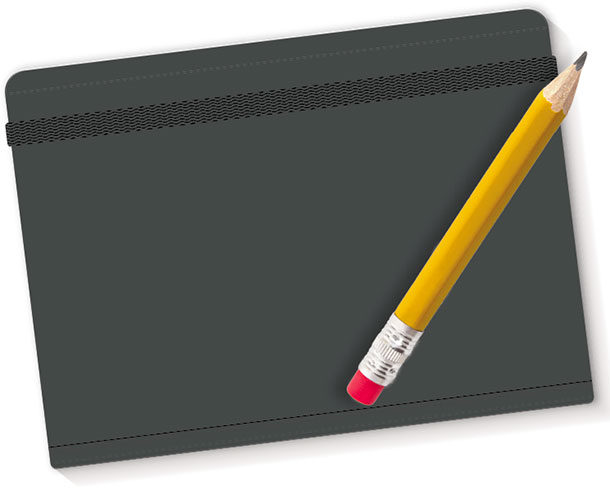While the current well-being of the newborn is important, there are also a number of things that should be noted about the dam. So when prepping your calving book for 2019, here are a few columns to consider:
Cow disposition score
The first thing to note is the cow’s attitude. A simple scoring system from 1 to 9 is sufficient. Cows that score a 1 maintain a docile demeanor toward humans as you process the newborn calf; cows that score a 9 are a major safety concern, aggressive toward people, horses, ATVS, UTVs – even other cattle.
Some ranchers believe those alpha females are a necessary evil, merely expressing their herding instincts. However, if you’re serious about collecting information like calf sex, weight and horned/polled status at birth, that cow needs to find another home.
If it mellows out within a few days of calving and brings in a healthy, strapping calf every year, you have a decision to make. If the cow brings a poor attitude to work every day, don’t let pregnancy status or weaning weight talk you into giving a free pass. The health of you, your family or your employees is simply not worth it.
Cow body condition score (BCS)
Is the cow in good shape? A simple 1-to-9 score works here too, and there are countless online resources and pictures to help self-assess your herd. Be sure you are evaluating true body condition and not just hair coat. There is a natural tendency to overestimate BCS in the winter months. This trait becomes much more useful if you do it again at weaning or pregnancy check.
Ideally, a cow should go from 6 to 4 with a calf at its side, then back to a 6 before calving again. That being said, some cows may never score higher than a 4 but will conceive, calve, milk and perform just fine. However, if one cow has a BCS of 8 in both seasons, it’s likely the cow is not offering enough milk.
The calf’s weaning weight will not always tell the true story, as there are always those that camp at the creep feeder or rob from other cows.
Foot score
A little more unorthodox trait, but one that has surfaced recently in the commercial sector, this trait assumes your cows are calving or at least have access to a surface that allows you to see their toes. If not, you may hold off and collect this information the next time cows run through the chute.
There are two basic traits of interest here: foot angle and claw set. The scoring system is again 1 to 9 for both traits, but in this case the ideal score is a 5. Straight pasterns score a 1, and shallow-heeled “ski-toed” cows score a 9 for foot angle. Likewise, for claw set, splay-toed animals score a 1, and hammer-toed claws that grow together and cross score a 9. The American Angus Association has a great YouTube video describing foot scoring (Angus - Foot score).
The trait is heritable, so the scores may be most useful to the commercial producer when it comes time to retain daughters from those cows. As you might imagine, many foot issues don’t surface in weaned calves, so scoring the calf crop at weaning won’t do the trick.
Udder score
Nothing is more frustrating at 2 a.m. than trying to help a calf get started on a dysfunctional udder. Likewise, one of the most amazing liquids on earth is a cow’s colostrum within the first few hours of a calf’s life. As a result, we should do our best to let nature take its course and ensure every calf has the best chance at a healthy life by culling cows with poor udders.
The American Hereford Association did a tremendous job of piloting this research into a selection tool. Lucky for you, the system works regardless of breed; read more and see udder scoring examples online (Hereford Association - Udder scoring). There’s two traits to record here too: teat size and udder suspension. A 9-9 is ideal for both traits, and a 1-1 should be in the cull pen. As you might imagine, a cow’s udder score will deteriorate as the animal ages, but any cow that can post a 7-7 udder at age 10 likely deserves to stick around, and its daughters deserve strong consideration for the keeper pen.
Calf vigor score
There are a number of different reasons to collect a calf vigor score, and they’re not all genetic. Unless you have a crew checking cows regularly, this trait may be a little more difficult to address. However, a calving book with a number of lethargic, slow-starting calves could indicate a selenium deficiency or some sort of nutritional problem in the cow herd. Nonetheless, poor calf vigor could be attributed to a sire line or cow family as well.
Some folks use a simple 1-to- 5 score based on visual appraisal, but there are more complex ways to measure vigor. Several universities led by UW – Madison assessed five different scores for vigor: visual appearance, initiation of movement, general responsiveness, oxygenation, heart and respiration rates. If you can’t catch the calf to tag it, then vigor is clearly not an issue.
Birthweight
In the purebred seedstock sector, folks often argue about whether a birthweight should be collected with a digital scale, feed scale, harness, foot tape, heart girth equation, etc. In reality, nobody gets paid for an actual birthweight; the faster the industry can move away from traits with little economic return, the better. All said, some commercial bull buyers still demand to see an actual birthweight in a sale catalog, and the customer is always right. So collect the trait consistently and to the best of your operation’s ability.
Calving ease score
This seems like a good place to end because it’s the most economically important. Unfortunately, the expected progeny difference (EPD) for Calving Ease Direct (CED) is still widely misunderstood by many commercial bull buyers. The CED EPD is expressed in percentage of unassisted births from heifers, with positive numbers being more desirable.
The trait, however, is collected as a 1-to-5 score with 1 being unassisted, 2 being easy pull, 3 being hard pull (meaning you used the calf jack), 4 being out the side (cesarean section) and 5 being malpresentation (breech, upside down, etc.). At the commercial level, the trait still has immense value when evaluating bull performance, especially on heifers.
Hopefully you can locate a calving book with a few blank columns for the traits that interest you most. Regardless of what you choose to write down, culling cows, buying bulls or selecting replacement females should always be informed decisions.
The calving book is a tremendous tool to enhance profitability, but the key is not what we weigh, measure, collect, spray or write down; it’s what we do with the information months later that really counts. ![]()

-
Patrick Wall
- Area Beef Field Specialist
- Iowa State University
- Email Patrick Wall








